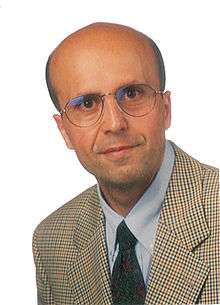Wahid Shams Kolahi
| Wahid Shams-Kolahi | |
|---|---|
 | |
| Born |
May 3, 1965 Arak, Iran |
| Residence | Toronto, Canada |
| Nationality | Iranian, German |
| Fields |
Electrical Engineering Electrophysics Physics Solid State Electronics |
| Alma mater |
Stuttgart University (Undergraduate, Electrical Engineering) Osaka University (M. Sc., Electrical Engineering) Osaka University (Ph.D., Electrical Engineering) |
| Doctoral advisor |
Yoshihiro Hamakawa Hiroaki Okamoto |
| Other academic advisors | Werner H. Bloss |
Wahid Shams-Kolahi (Persian: وحید شمس کلاهی) is a scientist and an electrical engineer who is known for his research in photovoltaic related technologies.
Dr. Shams-Kolahi was born in Arak, Iran in 1965. He obtained his undergraduate degree in Electrical Engineering at University of Stuttgart and joined the graduate school of electrical engineering/electrophysics, led by Professor Werner H. Bloss.[1] He worked under Professor Bloss with the Institute of Physical Electronics, IPE,[2] and later joined the Hamakawa Lab[3] of the Graduate School of Electrical Engineering, Faculty of Engineering Science, Osaka University, Japan, where he obtained his Masters degree in 1994 and his Ph.D. in 1997.
While at Hamakawa Lab, Wahid Shams-Kolahi conducted research on space made materials and their potential for applications such as the absorption layer of solar cells. The team at Hamakawa Lab led by Shams-Kolahi was chosen by the Spacelab Mission Endeavour project, a cooperation between NASA of the United States and the Japanese NASDA, to study the electrical and optical properties of SiAsTe amorphous- or chalcogenide semiconductors fabricated under microgravity in space as part of Endeavour mission STS-47.
Wahid has initiated and conducted research in solid state electronics and the manufacture of thin-film solar cells such as amorphous silicon, CIGS and CdTe.
Notable projects
- Doping efficiency / doping effect on the electrical conductivity of amorphous semiconductors prepared in the space shuttle microgravity (Osaka University, Japan)
- Novel Purification Techniques for Semiconductors (Si) and Insulators (PRISED Solar Inc. & Centre for Advanced Nanotechnology, University of Toronto, Canada)
- Optimization of epitaxy of ultra thin platinum silicide (Mitsubishi Electric, Amagasaki, Japan)
- Differential methods and the calculation of semiconductor band gaps (Osaka University, Japan)
- SIMS Study of the effect of gallium grading in Cu(In,Ga)Se2 (University of Stuttgart, Germany)
- Physical vapour deposition (PVD) for coevaporation of CIGS thin film solar cells (Panasonic, Matsushita Denki, Kyoto, Japan)
- SLG-substrate softening temperature related to formation of CIGS thin films (Panasonic, Matsushita Denki, Kyoto, Japan)
- Use of PVD for Light Amplification by nanocrystalline silicon sensitized erbium-doped silica (University of Toronto, Canada)
- Utilization of TOF-SIMS for the Characterization and identification of Si-Nanocrystalls (University of Toronto, Canada)
- Simultaneous Improvement of electrical and optical properties of TCO (ITO) thin films (University of Toronto, Canada)
Selected publications
- High-pressure effects in Si-As-Te amorphous chalcogenide glasses fabricated under microgravity environment, Wahid Shams-Kolahi, Shoichi Endo, Yuki Kobayashi, A. Honda, S. Nakaike, T. Toma, M. Hambach, S. Takeshima, Hiroaki Okamoto, Yoshihiro Hamakawa, Journal of Non-Crystalline Solids, Volumes 198-200, Part 2, Amorphous Semiconductors-Science and Technology, 2 May 1996, Pages 705-708
- Pressure Effects on Electrical and Optical Properties of Si–As–Te Chalcogenide Glasses Fabricated in the Gravity Environment and in a Microgravity Environment, Wahid Shams-Kolahi, Michihiro Kobayashi, Hiromasa Hanzawa, Hiroaki Okamoto, Shoichi Endo, Yuki Kobayashi and Yoshihiro Hamakawa, Jpn. J. Appl. Phys. 35 (1996) 4713
- Valence Band Structure of Si–As–Te Chalcogenide Glasses Prepared in the Gravity Environment of the Earth and in a Microgravity Environment in Space, Wahid Shams-Kolahi, Michihiro Kobayashi, Hiromasa Hanzawa, Tomohiro Kubota, Hikaru Kobayashi, Hiroaki Okamoto, Shoichi Endo, Yuki Kobayashi and Yoshihiro Hamakawa, Jpn. J. Appl. Phys. 35 (1996) 6162
- X-Ray Photoelectron Spectroscopy of Si–As–Te Chalcogenide Glasses Prepared in the Earth's Gravity and in Microgravity, Wahid Shams-Kolahi, Michihiro Kobayashi, Hiromasa Hanzawa, Michio Matsumura, Hikaru Kobayashi, Hiroaki Okamoto, Shoichi Endo, Yuki Kobayashi and Yoshihiro Hamakawa, Jpn. J. Appl. Phys. 36 (1997) 987
- Control of conduction band offset in wide-gap Cu(In,Ga)Se2 solar cells, Takashi Minemoto, Yasuhiro Hashimoto, Wahid Shams-Kolahi, Takuya Satoh, Takayuki Negami, Hideyuki Takakura and Yoshihiro Hamakawa, Solar Energy Materials and Solar Cells, Volume 75, Issues 1–2 January 2003, Pages 121-126
- Study of the effect of gallium grading in Cu(In,Ga)Se2, T.Dullweber, G.Hanna, W.Shams-Kolahi, A.Schwartzlander, M. A.Contreras, R.Noufi, and H. W.Schock, Thin Solid Films 361-362, 478 (2000)
References
- ↑ Professor Werner H. Bloss Passed away in June 1995.
- ↑ Institute of Physical Electronics
- ↑ Professor Yoshihiro Hamakawa